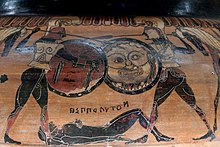Heta
The Heta is a temporarily used letter of the Greek alphabet for the sound [ h ] . Previously it was the pre-classical name for the 7th letter Eta .
origin
see Ancient Greek Phonology Fricatives

1) Old Athens a. a.
2) classic (Ionic)
3) Delphi u. a.
4) Tarent u. a.
5) late antiquity.

The H sign was first adopted from the Phoenician alphabet as the letter Η Heta and used for the rough touch [h]. Here it came over also into Latin alphabet, where the present H was. When the [h] sound fell silent in the Ionic dialect, the character Η was used as the eta for the [ε:] sound. However, when the Ionic alphabet was introduced in the regions that spoke the rough touch [h] (especially in Attica), there was no symbol for it. Therefore, in some inscriptions, the letter Η was cut in half vertically in the middle and the left half of the capital Η ( Ͱ , similar to ├) was used for the breath [h] at the beginning of a word beginning with a vowel or R , for the initial sound of a word only with a vowel ( without a hint) the right half of the capital letter Η (Ͱ, similar ┤). Later during the Hellenistic and Byzantine times, the two characters Spiritus asper (῾) and Spiritus lenis (᾿) developed from this .
literature
- Raphael Kühner, Friedrich Blass: Detailed grammar of the Greek language. Hahn, Hannover / Leipzig 1890, reprint Hannover (Hahnsche Buchhandlung) 1992, ISBN 3-7752-5191-X ( perseus.tufts.edu )
Web links
- Thesaurus Linguae Graecae . tlg.uci.edu (English)

